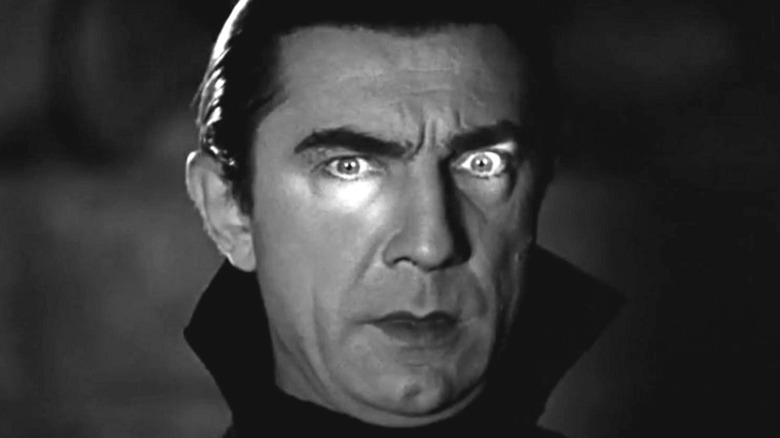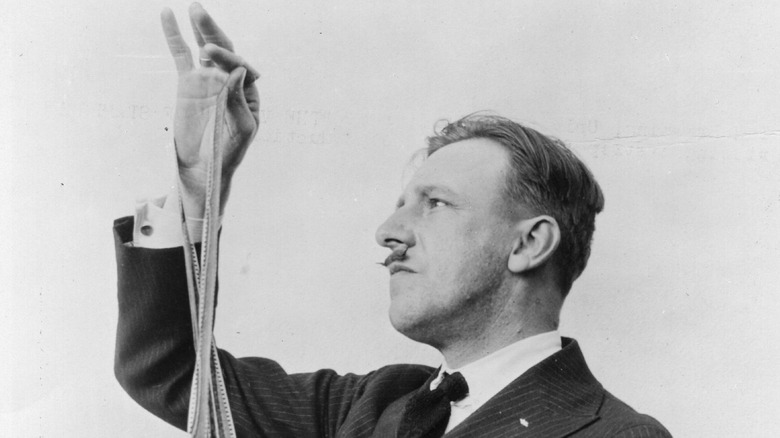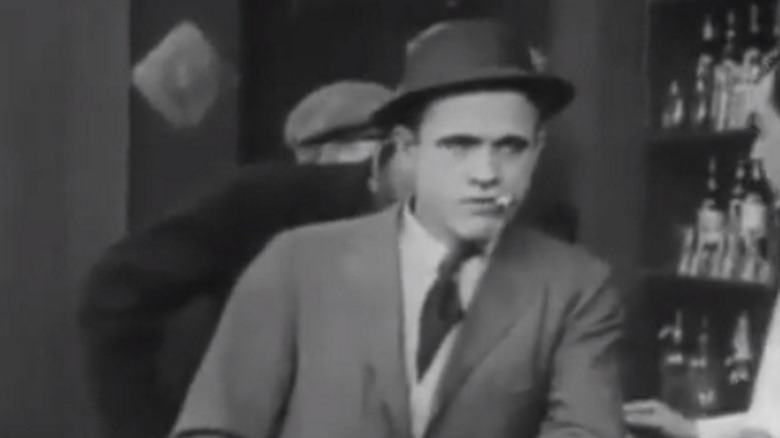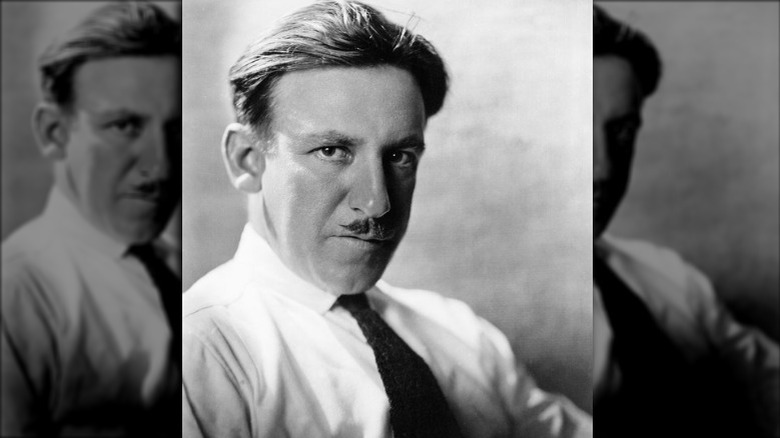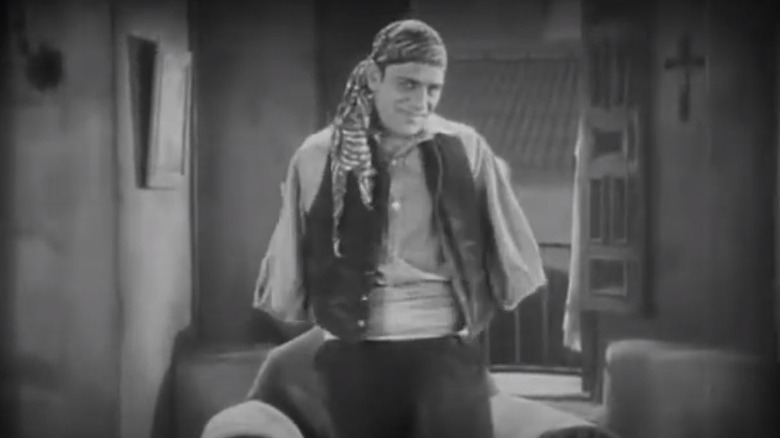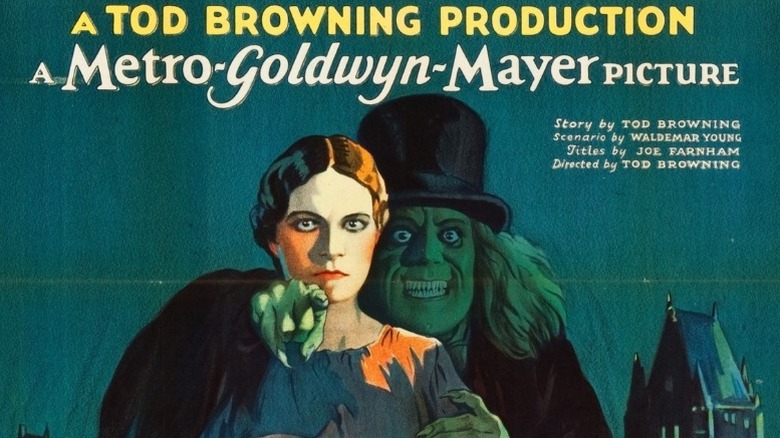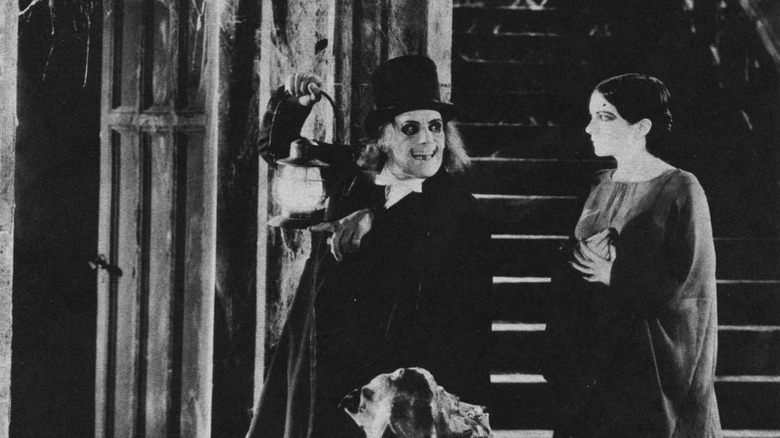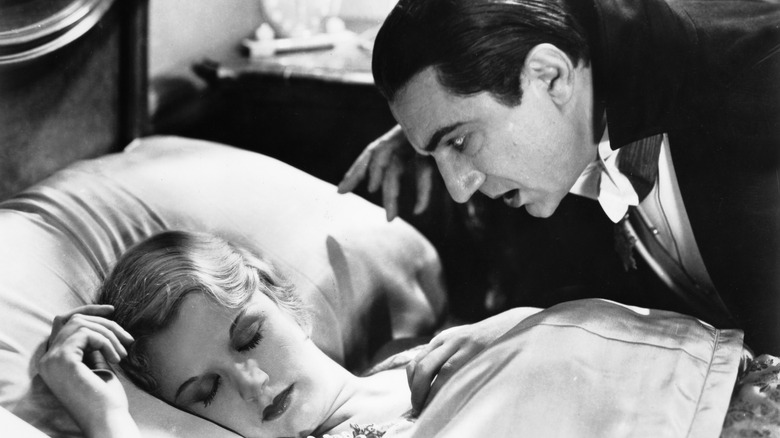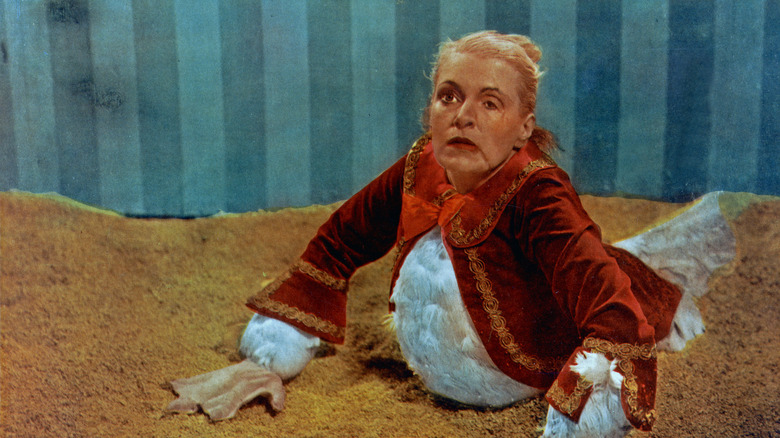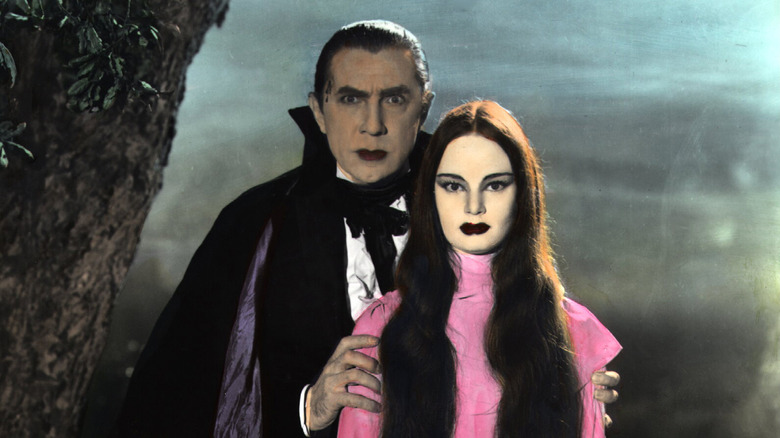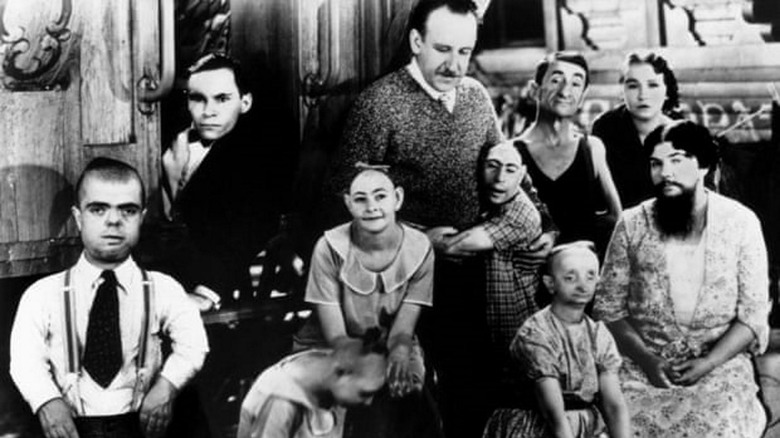The Tragic True Story Of The Man Who Directed 1931's Dracula
Released on Valentine's Day 1931, "Dracula" ushered in the golden age of horror and established Universal Studios as the home of the classic movie monsters. Although Bram Stoker's novel had been previously brought to the screen in 1922 as "Nosferatu," an unofficial German adaptation that was nearly lost because of a copyright lawsuit brought by the author's widow, Universal's film established Dracula as a cornerstone of pop culture on par with Mickey Mouse and Santa Claus.
The brainchild of Universal's head of production Carl Laemmle Jr., a sound adaptation of Stoker's novel seemed a sure bet to ease the cash-strapped studio's Depression-era woes. However, "Dracula" would need a steady hand at the helm. As detailed by author David J. Skal in "The Monster Show: A Cultural History of Horror," German filmmaker Paul Leni was initially attached to Junior Laemmle's horror film. Sadly, Leni would die in 1929 before the project could get off the ground.
"Dracula" would instead go to veteran silent film director Tod Browning. Browning, known for his successful collaborations with actor and makeup wizard Lon Chaney, had wanted to bring Stoker's novel to the screen since the early 1920s. In 1930, he would get his shot.
An unqualified box office success, "Dracula" propelled Browning into the cinematic stratosphere. Yet, less than a decade after directing one of the most popular and profitable films of all time, he was virtually unemployable. Tod Browning was a victim of both his unique vision and his personal demons. This is his tragic true story.
Tod Browning was a born showman
Born Charles Albert Browning in Louisville, Kentucky, on July 12, 1880, Tod Browning was the second son of Charles Lester Browning and Lydia Jane Fitzgerald Browning. His uncle, Pete "The Gladiator" Browning, was a professional baseball player. A top hitter for the Louisville Colonels, Pete had a penchant for showmanship and a love of hard liquor — traits that would also characterize his nephew.
Tod Browning had a knack for entertaining from an early age. As a member of the choir at Louisville's Christ Church Cathedral, he delighted the congregation with his angelic singing voice. Soon, however, Browning discovered that in addition to uplifting souls, he could also use his talents to line his pockets. As recounted in "The Monster Show," during summer vacations, young Tod put on elaborate plays in his family's backyard shed. Ranging from musicals to melodramas, Browning wrote, directed, and acted in as many as five productions per summer. By charging an admission of a few pennies for his amateur theatricals, Browning learned a lesson that would serve him well: Show business is profitable. He also learned that audiences were willing to pay more for bigger and more spectacular entertainment. Consequently, Browning's backyard kiddie shows regularly out-grossed those of his neighborhood competition.
As a teenager, Browning enrolled at Louisville's Boys' High School. His education there, however, was short-lived. A stop for showboats and carnivals, Louisville was filled with a promise of an unconventional life that Browning found irresistible. At 16, he left home for the road.
Teenage Tod Browning ran away with the carnival
Much to the consternation of his parents, Tod Browning developed an affinity for travelers and showpeople. Especially intriguing were the Roma people who arrived yearly during the Kentucky Derby. As recounted by David J. Skal, young Browning would spend hours wandering the travelers' encampments, fascinated by their culture and their seeming disregard for the conventional world.
At 16, Charles Albert Browning heeded the call of the road. Rechristening himself "Tod," he fulfilled the dream of nearly every adolescent boy by running away with the carnival. Roaming up and down the Ohio and Mississippi Rivers, Browning began his new life in the lowest echelons of the show trade. While traveling with the carnival, he worked as a barker for a phony "wild man" and later as an escape artist, a contortionist, and an acrobat. His most unusual job was performing as "The Hypnotic Living Corpse." In the macabre act, Browning would pose as a recently deceased man who's buried and "resurrected" after a day, sometimes two. Interred in a specially ventilated coffin, Browning would subsist on a stash of malted milk balls with only his thoughts to occupy him while underground.
Browning gradually worked his way into more reputable areas of show business, eventually becoming a vaudeville performer. In 1913, he at last embarked on the pursuit that would best serve his creative passions and later reflect his darker obsessions. Offered an acting role by director D.W. Griffith, Tod Browning was on his way to a career in the new medium of cinema.
Browning's recklessness caused an actor's death
Tod Browning would appear in several short comedies for New York's Biograph Studios. However, the fledgling actor would soon find himself in the capital of the film industry when D.W. Griffith landed the job of chief of production for the Reliance and Majestic film companies. Following his mentor to the West Coast, Browning transitioned into directing in 1915.
Tod Browning loved a good time, and Hollywood was a vice-filled playground for the free-wheeling director. Having spent his youth in tawdry sideshows, Browning had grown up, as David J. Skal writes, "according to the outsider's code of the carnival," which had left him imbued with a marked disrespect for laws and propriety, which, combined with his love of whiskey and fast cars, would prove a deadly combination.
In the early morning hours of June 16, 1915, Browning, director George A. Siegmann, and actor Elmer Booth (pictured) were returning from a night of partying at a California roadhouse known as the Vernon Country Club. Their vehicle, driven by a drunk Tod Browning, collided with a railway car loaded with steel rails. According to Skal, the train's conductor had frantically attempted to signal the oncoming car, to no avail. Browning's vehicle struck the flatcar at full speed, launching Elmer Booth headfirst into the jutting rails and killing him instantly. Siegmann escaped with broken ribs, a lacerated thigh, and internal injuries. Browning was gravely injured, with a shattered leg and unspecified internal injuries. The press publicly predicted he would die.
Tod Browning's scandalous crash left him changed
One of a number of deadly accidents that plagued the roadways around the notorious Vernon Country Club, Tod Browning's crash remains mysterious. The survivors' reticence in discussing the crash with the authorities, whether induced by the trauma of the accident or concocted as a cover-up of the previous evening's salacious details, smacked vaguely of scandal. The front page of the Los Angeles Times shouted, "WERE ANY WOMEN IN CAR WHEN ACTOR WAS KILLED?"
Despite his grave condition, Browning miraculously survived the auto accident that took Elmer Booth's life. His brush with death, however, left him a changed man. No longer the happy-go-lucky clown who delighted audiences in countless comedies, Browning embraced a somberness that would mark his work to the end of his career. The accident had also made him at least one enemy. As detailed in "The Monster Show," Elmer Booth's sister Margaret, who would go on to become one of the film industry's most respected editors, never forgave the director for her brother's death. In the 1970s, she rejected Browning biographer Elias Savada's attempt at an interview with, "You expect me to talk about that man who killed my brother?"
In under a year, Browning was back working in film — first as a writer and then as an actor. His first post-accident role would ironically find him behind the wheel as the driver tasked with rushing actress Mae Marsh to save her husband from the gallows in D.W. Griffith's epic film "Intolerance."
Browning's alcoholism nearly cost him his career
As recounted by Turner Classic Movies, Tod Browning returned to directing in 1917, and his first post-accident project was also his first feature-length film. Co-directed with actor Wilfred Lucas, "Jim Bludso" was a Civil War melodrama that marked Browning's turn from slapstick comedy to serious subject matter.
Between 1917 and 1923, Tod Browning worked steadily in Hollywood, directing a series of now-lost films for Universal Pictures and MGM. Although films such as "The Wicked Darling," his first collaboration with actor Lon Chaney, and "The Virgin of Stamboul," his first commercial hit, made Browning a popular director and a bankable asset for the studios, his personal life was spiraling out of control. A functional alcoholic, Browning had always been able to keep his drinking in check. According to "The Monster Show" author David J. Skal, Browning's friend and fellow director Raoul Walsh was aware of Browning's drinking but never saw him lose control. "I knew he was from Kentucky because he was always talking about Kentucky whiskey," Walsh said. "[H]e always had a bottle of laughing water with him. He never got drunk, though."
However, the death of Browning's father proved a nearly insurmountable emotional obstacle for the director. By 1923, his drinking began to take a toll on both his career and his marriage. Universal Studios ended his contract, and Browning's wife left him.
Lon Chaney was the canvas for Browning's dark vision
As recounted in "The Monster Show," Tod Browning made the second miraculous comeback of his career in 1925. A reconciliation with his wife spurred by Browning's commitment to curtail his drinking led to his return to the director's chair. In an interview with Motion Picture Classic writer Joan Dickey, Browning frankly explained his two-year absence from the movies as a result of trying to "drink up all the bad liquor in the world."
Given a second chance at a directing career by MGM's Irving Thalberg, Browning would again team with Lon Chaney for "The Unholy Three." Based on Tod Robbins' 1927 novel, the film stars Chaney as the ringleader of an unlikely gang of circus performers who go on a crime spree. Deemed one of the 10 best pictures of 1925 by The New York Times, "The Unholy Three" was the beginning of an eight-film partnership between Chaney and Browning.
Famous for going through often excruciating transformations to bring such characters as the Hunchback of Notre Dame to the screen, Chaney was the perfect vehicle through which Browning could express his obsessions with disfigurement and deformity. Browning's next film, "The Blackbird," starred Chaney as the contortionist leader of a criminal gang who poses as his own physically disabled twin.
Among the best of the Browning/Chaney collaborations is "The Unknown." Another dark tale of the sideshow, "The Unknown” stars Chaney as Alonzo the armless, a knife thrower who goes to horrible extremes to win the love of a woman who recoils at the touch of men.
Tod Browning directed the most famous lost film of all time
Ironically, one of Tod Browning's most famous films remains unseen by modern audiences. "London After Midnight," originally released in 1927, stars Lon Chaney in dual roles as Scotland Yard inspector Burke, tasked with investigating a mysterious death, and the sinister Man in the Beaver Hat, a vampire who haunts the deceased man's home.
Lon Chaney's bug-eyed, shark-toothed makeup in "London After Midnight" has become an indelible image long associated with the horror genre's silent era. Although the film borrows much of its spooky atmosphere directly from the stage adaptation of "Dracula," and, as Browning biographers David J. Skal and Elias Savada point out, Chaney's top-hatted look is "rather obviously" patterned after Werner Krauss' character in "The Cabinet of Dr. Caligari," "London After Midnight" is not a horror film. It's a mystery with a twist in which Chaney's vampire is merely a disguise Burke uses to help him nab a murderer.
Unfortunately, the last known print of "London After Midnight" was destroyed along with hundreds of other films in a fire that leveled one of MGM's vaults in 1967. Popularized in such mid-century genre magazines as "Famous Monsters of Filmland," the film's reputation has grown despite many negative contemporary reviews. Still, film historians and horror fans consider the discovery of a complete print of the film a "holy grail." Ultimately, "London After Midnight's" true legacy is giving insight into what a Browning/Chaney adaptation of "Dracula" might have been.
Lon Chaney's death derailed Browning's vision of Dracula
According to authors David J. Skal and Elias Savada, "London After Midnight" may have originally been conceived as an unofficial adaptation of "Dracula." However, MGM head Irving Thalberg, aware of the controversy over "Nosferatu," had no interest in becoming embroiled in a copyright suit with Bram Stoker's estate. Thematically too close for comfort, the script was changed at Thalberg's request. Nevertheless, Tod Browning had long hoped to direct an adaptation of the vampire novel. Skal writes, "[Browning] also wanted very much to do a straight adaptation of 'Dracula' with Chaney in the title role. The New York Times reported, nine years after the fact, that 'Chaney wanted to act Dracula and often discussed the part with Tod Browning...Both men believed the American public to be 90 per cent superstitious and ripe for horror films. Chaney had a full scenario and a secret makeup worked out even at that early date...'"
After protracted negotiations and a slew of competing offers from rival studios, Universal acquired exclusive rights to "Dracula" for $40,000. By 1929, Tod Browning had resumed the heavy drinking that had gotten him blacklisted in the early 1920s. Released from his MGM contract, Browning was scooped up by Universal to helm "Dracula" in hopes that Lon Chaney would follow. Sadly, Chaney, a heavy smoker, would die of lung cancer before the film went into pre-production. Had he lived to be cast in the part, it is likely that Chaney's makeup prowess would have radically reshaped the film.
Dracula marked a rough transition to talkies for Browning
An instant classic, "Dracula" was a critical and financial hit. As detailed by Mark A. Viera in "Hollywood Horror: From Gothic to Cosmic," the film immediately struck a chord with audiences, selling 50,000 tickets in two days. "Dracula" would gross $700,000, making it Universal's most profitable release of 1931.
Nevertheless, "Dracula" is an incredibly flawed film, and many of its imperfections can be traced to Tod Browning. Having directed just two talkies prior to "Dracula," Browning's discomfort with the new medium is evident in his flat direction, uneven editing, and disregard for continuity. Some of Browning's work in "Dracula" is shockingly sloppy. In two scenes, a large piece of cardboard used to cut the glare from a lamp is clearly visible, taking up nearly a quarter of the screen.
In an interview with David J. Skal, "Dracula" co-star David Manners remembered Browning as a disinterested director. "Tod Browning was always off to the side somewhere," Manners recalled. The actor also credited cinematographer Karl Freund for the film's success. "I remember being directed by Karl Freund ... I believe that he is the one who is mainly responsible for 'Dracula' being watchable today."
Freaks was the beginning of the end for Tod Browning
Universal's back-to-back hits with "Dracula" and "Frankenstein" made horror a hot commodity in Hollywood, and MGM wanted its piece of the action. With Browning's return to MGM, Irving Thalberg gambled that the problematic director would deliver another monster-sized hit.
According to horror expert David J. Skal, "Freaks" had been a project Browning had wanted to direct since 1929. With the success of "Dracula," he finally had the leverage to make the film. A tale of betrayal and revenge set in a circus sideshow, "Freaks" would encompass all of Browning's dark obsessions. However, his decision to cast circus performers with real physical anomalies proved too much for both audiences and MGM.
Public outrage was strong and immediate. MGM pulled the film from theaters and, according to legend, dumped the original negative into the San Francisco Bay. Although the film would be reevaluated as a groundbreaking cult classic in the 1960s, "Freaks” did irreparable damage to Tod Browning's reputation in Hollywood.
Browning's directing career lasted only eight years after Dracula
Although "Freaks" was an unmitigated disaster for MGM, Tod Browning managed to stay in the studio's good graces for four more pictures, culminating with the 1939 mystery-thriller "Miracles For Sale."
As detailed in David J. Skal's "The Monster Show," Browning's most notable film during his post-"Dracula" tenure at MGM is "Mark of the Vampire." Released in 1935, "Mark of the Vampire" is a virtual remake of "London After Midnight." Starring Bela Lugosi and Carol Borland as a pair of actors posing as vampires in the service of a murder investigation, the film faced major studio-imposed edits due to a subplot involving incest. Cut from 80 to 60 minutes, "Mark of the Vampire," in many ways, has a vitality that "Dracula" lacks, leading some film scholars to suspect Browning's approach to the thematically similar subject matter was a pointed comment on the experience of directing the earlier film.
Leaving his long filmmaking career behind him, Browning left Hollywood for good in 1942.
Tod Browning's tragic final years
Wealthy from real estate investments, Tod Browning transitioned into an anonymous life in Malibu, California. As detailed by horror historian Nige Burton of Classic Monsters, his wife died in 1944. Variety printed Browning's obituary instead — the confusion stemming from his reclusive lifestyle. Even close neighbors rarely saw him. As noted in "Tod Browning's Freaks: The Sideshow Cinema," the "Dracula" director never gave a retrospective interview.
Sometime in the 1950s, Browning developed throat cancer that necessitated a laryngectomy. In 1959, his brother Avery died. Unwilling to let his family see the extent of his disease, Browning secluded himself in a private room at the funeral home, and, according to David J. Skal, Browning's desire for privacy left his fellow mourners "angry and alienated."
On October 6, 1962, just as "Freaks" was beginning its arthouse revival. Tod Browning died alone in the bathroom of friends who had taken him in. He was 82.
